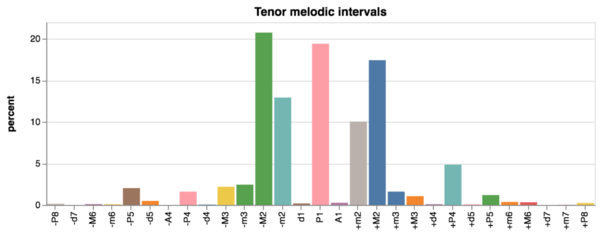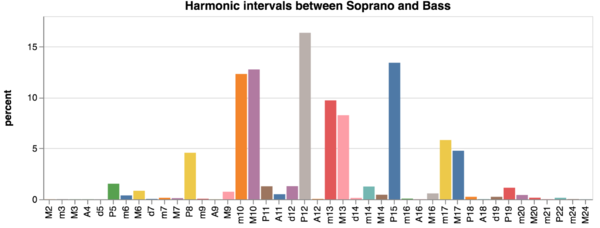Difference between revisions of "Humdrum homework"
| Line 15: | Line 15: | ||
| − | Make plots | + | Make plots comparing each pair of parts bass (spine 1), tenor (spine 2), alto (spine 3), and soprano (spine 4), which is a total of 6 plots. |
Questions: | Questions: | ||
| − | + | 3. What is the most common harmonic interval between each part pair? | |
| − | |||
| + | |||
| + | === Scale Degrees === | ||
=== Harmonic intervals === | === Harmonic intervals === | ||
Revision as of 18:28, 7 March 2019
Contents
Music 253 Humdrum Homework
Examine the melodic and harmonic properties of the Bach chorale data set. Refer to Humdrum Lab 1 for how to download the chorales (and install the tools useful for the homework).
Melodic intervals
Here is a template for extracting the melodic intervals for the Tenor part in the chorales and plotting them in a histrgram by percentages:
extractx -s 2 *.krn | mint | grep -v r | ridx -H | grep -v [[] | \
sortcount -vp --sort interval -T "Tenor melodic intervals" > melodic-tenor.html
This plot should be displayed when opening up the generated HTML file:
Make plots comparing each pair of parts bass (spine 1), tenor (spine 2), alto (spine 3), and soprano (spine 4), which is a total of 6 plots.
Questions:
3. What is the most common harmonic interval between each part pair?
Scale Degrees
Harmonic intervals
Here is an example of how to extract the harmonic intervals between the soprano and bass parts:
extractx -s 1,4 *.krn | hint | ridx -H | grep -v [r-] | sortcount -pv -T "Harmonic intervals between Soprano and Bass" --sort interval > analysis.html
This plot should be displayed when opening up the generated HTML file:

